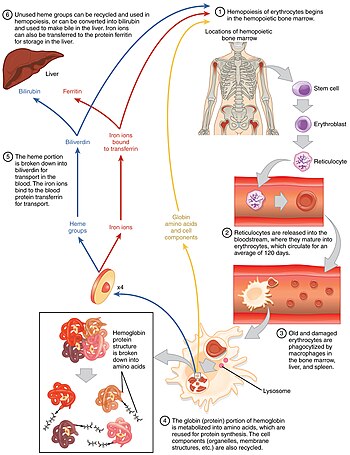
Back تكون الكريات الحمر Arabic Еритропоеза Bulgarian Eritropoeza BS Eritropoesi Catalan Эритропоэз CE Erythropoese German Eritropoyesis Spanish Erütropoees Estonian Eritropoiesi Basque اریتروپوئز Persian
This article needs additional citations for verification. (October 2019) |

Erythropoiesis (from Greek 'erythro' meaning "red" and 'poiesis' "to make") is the process which produces red blood cells (erythrocytes), which is the development from erythropoietic stem cell to mature red blood cell.[1]
It is stimulated by decreased O2 in circulation, which is detected by the kidneys, which then secrete the hormone erythropoietin.[2] This hormone stimulates proliferation and differentiation of red cell precursors, which activates increased erythropoiesis in the hemopoietic tissues, ultimately producing red blood cells (erythrocytes).[2] In postnatal birds and mammals (including humans), this usually occurs within the red bone marrow.[2] In the early fetus, erythropoiesis takes place in the mesodermal cells of the yolk sac. By the third or fourth month, erythropoiesis moves to the liver.[3] After seven months, erythropoiesis occurs in the bone marrow. Increased levels of physical activity can cause an increase in erythropoiesis.[4] However, in humans with certain diseases and in some animals, erythropoiesis also occurs outside the bone marrow, within the spleen or liver. This is termed extramedullary erythropoiesis.
The bone marrow of essentially all the bones produces red blood cells until a person is around five years old. The tibia and femur cease to be important sites of hematopoiesis by about age 25; the vertebrae, sternum, pelvis and ribs, and cranial bones continue to produce red blood cells throughout life. Up to the age of 20 years, RBCs are produced from red bone marrow of all the bones (long bones and all the flat bones). After the age of 20 years, RBCs are produced from membranous bones such as vertebrae, the sternum, ribs, scapulas, and the iliac bones. After 20 years of age, the shaft of the long bones becomes yellow bone marrow because of fat deposition and loses the erythropoietic function.[5]
Comparison of erythrocyte production by marrow stem cell lines from old and young adult donors shows no significant differences.[6] This finding implies that little or none of the proliferative capacity of the erythropoietic stem cells is exhausted by a lifetime of normal functioning.[6]
- ^ Pelley, John W. (2007-01-01). "Amino Acid and Heme Metabolism". Elsevier's Integrated Biochemistry. pp. 97–105. doi:10.1016/B978-0-323-03410-4.50018-3. ISBN 9780323034104.
Erythropoiesis
Heme synthesis is coordinated with globin synthesis during erythropoiesis and as such does not occur in the mature erythrocyte. Erythropoiesis is the development of mature red blood cells from erythropoietic stem cells. The first cell that is morphologically recognizable in the red cell pathway is the proerythroblast. In the basophilic erythroblast, the nucleus becomes somewhat smaller, exhibiting a coarser appearance, and the cytoplasm becomes more basophilic owing to the presence of ribosomes. As the cell begins to produce hemoglobin, the cytoplasm attracts both basic and eosin stains and is called a polychromatophilic erythroblast. As maturation continues, the orthochromatophilic erythroblast extrudes its nucleus and the cell enters the circulation as a reticulocyte. As reticulocytes lose their polyribosomes, they become mature red blood cells. - ^ a b c Sherwood, L, Klansman, H, Yancey, P: Animal Physiology, Brooks/Cole, Cengage Learning, 2005.
- ^ Palis J, Segel GB (June 1998). "Developmental biology of erythropoiesis". Blood Rev. 12 (2): 106–14. doi:10.1016/S0268-960X(98)90022-4. PMID 9661799.
- ^ Le, Tao; Bhushan, Vikas; Vasan, Neil (2010). First Aid for the USMLE Step 1: 2010 20th Anniversary Edition. USA: The McGraw-Hill Companies, Inc. pp. 124. ISBN 978-0-07-163340-6.
- ^ Sembulingam, K.; Sembulingam, Prema (2012-09-30). Essentials of Medical Physiology. JP Medical Ltd. p. 71. ISBN 978-93-5025-936-8.
- ^ a b Harrison, David E. (1979). "Proliferative capacity of erythropoietic stem cell lines and aging: An overview". Mechanisms of Ageing and Development. 9 (5–6): 409–426. doi:10.1016/0047-6374(79)90082-4. PMID 37376. S2CID 31601624.